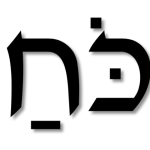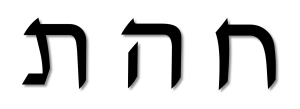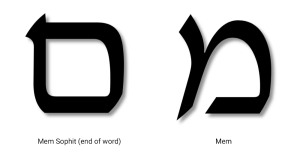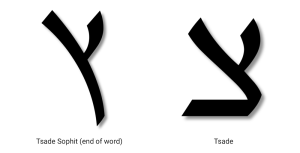For then will I turn to the people a pure language, that they may all call upon the name of the Lord, to serve him with one consent.
Zephaniah 3:9 (KJV)
Language – I believe the pure language that is being referenced here is Hebrew. I believe it was the language God spoke when He created everything in Genesis. We know it’s the language spoken during the 1st century when referencing religious things (Acts 21:40), and it was the language Yeshua spoke to Apostle Paul on the road to Damascus (Acts 26:14). So maybe it’s about time I learn it more fluently myself.
I thought I’d make a list of some of the quirks I’ve encountered in the Hebrew language.
1. Vowels
I can now read Hebrew as long as it has the vowels indicated. If the vowels aren’t shown, which often times they aren’t, forget it. You see, Hebrew’s alphabet comprises solely of consonants. The vowels have to be indicated by little dots and lines above or below each letter.

2. Word Structure
In Hebrew the word structure is Consonant + Vowel + Consonant + Vowel (CvCv). So after every consonant, a vowel must exist except when the consonant ends the word. This is unlike English where it could be CvvC (ie. road) or vCC (ie. act). And it works until the letter, hhet, is ending a word; then the word’s vowel gets swapped to be CvvC. Take for example, this letter combination which should sound like Ko-Hha, but ends up sounding Ko-aHh.

3. The Silent Vowel
For a language that doesn’t have vowels in its alphabet, I’m baffled that there is a need for a silent vowel at all. As mentioned above, there are times we abandon the CvCv word structure. Take the word below; the two red letters have a hard ending sound. The second one from the right, beyt, is without its dagesh (dot in the middle), so it’s pronounced ‘v’ instead of ‘b.’ The two dots under it indicate, for this letter in this specific moment, that the vowel, which should make an ‘eh’ sound, is silent. So the word sounds like LayV-Mah.

4. Look-alike Letters
I’ve always felt the English alphabet had a decent variety of letter shapes, and now that I’ve been studying Hebrew, the English alphabet’s variety is absolutely fantastic. Hebrew, on the other hand, has letters that are just way too similar.
Take a look at these two letters. They are different letters and pronunciations. Crazy, I know. The one on the right is the nun sophit, the nun when it ends a word, and is pronounced as ‘n.’ The one on the left is a vav and pronounced with a ‘v’ sound. Completely different letters.

Or look at these three different letters. Yep, exactly. On the right is the letter hhet, in the middle is the letter hey, and on the left is the letter tav. While they all look very much alike, they don’t sounds alike.

Or how about these two letters; the right is a beyt, and the left one is called the kaph.

Another set includes the gimmel, on the right, compared with the nun, on the left.

And there’s the samehh displayed on the right which looks very similar to the mem sophit on the left.

Oh, oh, don’t forget about these either! The right is the resh, and the left one is the kaph sophit, or the kaph when it ends a word.

Last similarity are these below. Seriously, Hebrew doesn’t have very many letters anyways, so why do so many need to look so similar? Here on the right is the letter ayin and on the left is the tsade.

5. Letter transformations
Wait, letters can change form in the middle of a word? No, not really. Some letters change form at the end of a word. The letters nun, mem, pey, kaph, and tsade all change their form when at the end of the word.





6. Sound-alike Vowels
So, in a language this crazy, I mean pure, it’s no wonder there’s more redundancy and confusion. 🙂 We’ve listed the look-alike letters, so now let’s list the sound-alike vowels. These are different vowels indicators that make the same sound. Yes, that’s right; different vowel indicators, same sound.
Short ‘a’ sound (3 vowels):

Short ‘e’ sound (3 vowels):

Long ‘o’ sound (4 vowels):

Long ‘u’ sound (2 vowels):

I’ll end here tonight. My mind is already boggling. While the language has evolved over many 1000’s of years, it’s still the original language of the Bible, and the people of God. It’s important for us to study Scripture as close to the original texts as possible. Hopefully this post can help you get a little closer.

Leave a Reply